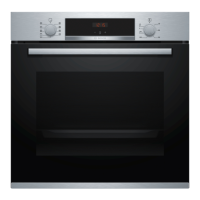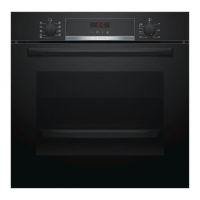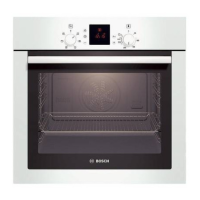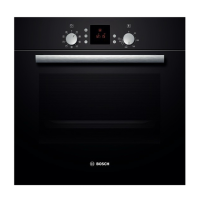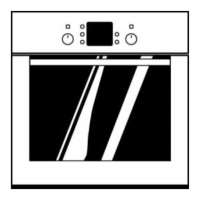en Cleaning and servicing
14
Cooking compartment
Area Suitable cleaning agents Notes
Enamel surfaces ¡ Hot soapy water
¡ Vinegar water
¡ Oven cleaner
Soak any heavily soiled areas and use a brush or steel wool.
Leave the appliance door open to dry the cooking compartment
after cleaning it.
Notes
¡ Enamel burns at very high temperatures, causing minor discol-
ouration. The functionality of your appliance is not affected by
this.
¡ The edges of thin trays cannot be completely enamelled and may
be rough. This does not impair corrosion protection.
¡ Food residues will leave a white coating on the enamel surfaces.
The coating does not pose a health risk. The functionality of your
appliance is not affected by this. You can remove residues with
lemon juice.
Self-cleaning sur-
faces
- Follow the instructions for self-cleaning surfaces.
→"Cleaning self-cleaning surfaces in the cooking compartment",
Page14
Glass cover for
the oven light
¡ Hot soapy water Use oven cleaner to remove very heavy soiling.
Rails ¡ Hot soapy water Soak any heavily soiled areas and use a brush or steel wool.
Tip:Remove the shelf supports for cleaning.
→"Shelf supports", Page15
Pull-out system ¡ Hot soapy water Use a brush to remove very heavy soiling.
Clean the pull-out rails while they are pushed in so that you do not
remove the lubricant.
Do not clean in the dishwasher.
Tip:Detach the pull-out system for cleaning.
→"Shelf supports", Page15
AccessorIes ¡ Hot soapy water
¡ Oven cleaner
Soak any heavily soiled areas and use a brush or steel wool.
Enamelled accessories are dishwasher-safe.
11.2 Cleaning the appliance
In order to avoid damaging the appliance, you must
clean your appliance only as specified, and with suit-
able cleaning products.
WARNING‒Risk of burns!
The appliance gets very hot.
▶
Never touch the inside surfaces of the cooking com-
partment or the heating elements while they are hot.
▶
Always allow the appliance to cool down.
▶
Keep children at a safe distance.
WARNING‒Risk of fire!
Loose food remnants, fat and meat juices may catch
fire.
▶
Before using the appliance, remove the worst of the
food residues and remnants from the cooking com-
partment, heating elements and accessories.
Requirement:Read the information on cleaning
products.
→"Cleaning products", Page13
1.
Clean the appliance using hot soapy water and a
dish cloth.
‒ For some surfaces, you can use alternative
cleaning agents.
→"Suitable cleaning agents", Page13
2.
Dry with a soft cloth.
11.3 Cleaning self-cleaning surfaces in the
cooking compartment
The back wall in the cooking compartment is self-clean-
ing. The self-cleaning surfaces are coated with a por-
ous, matt ceramic layer and have a rough surface.
When the appliance is in operation, the self-cleaning
surfaces absorb splashes from baking, roasting or
grilling and break them down. If the self-cleaning sur-
faces no longer clean themselves adequately during
operation, heat up the cooking compartment specific-
ally to the right temperature.
ATTENTION!
If you do not clean the self-cleaning surfaces regularly,
they may become damaged.
▶
If dark stains are visible on the self-cleaning sur-
faces, heat up the cooking compartment.
▶
Do not use oven cleaner or abrasive cleaning aids.
If oven cleaner accidentally comes into contact with
the self-cleaning surfaces, dab it off immediately us-
ing water and a sponge cloth. Do not rub.
1.
Remove accessories and cookware from the cook-
ing compartment.
2.
Unhook the shelf supports and remove them from
the cooking compartment.
3.
Use a detergent solution and a soft cloth to remove
heavy soiling:
– From the smooth enamel surfaces
– From the inside of the appliance door
– From the glass cover for the oven light
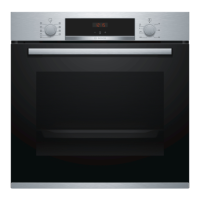
